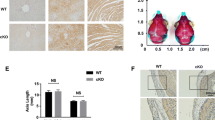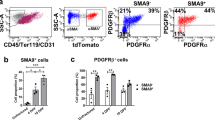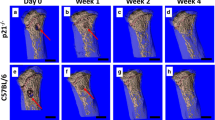Abstract
Endochondral ossification, an important stage of fracture healing, is regulated by a variety of signaling pathways. Transforming growth factor β (TGFβ) superfamily plays important roles and comprises TGFβs, bone morphogenetic proteins (BMPs), and growth differentiation factors. TGFβs primarily regulate cartilage formation and endochondral ossification. BMP2 shows diverse efficacy, from the formation of skeleton and extraskeletal organs to the osteogenesis and remodeling of bone. G-protein-coupled receptor kinase 2-interacting protein-1 (GIT1), a shuttle protein in osteoblasts, facilitates fracture healing by promoting bone formation and increasing the secretion of vascular endothelial growth factor. Our study examined whether GIT1 regulates fracture healing through the BMP2 signaling pathway and/or through the TGFβ signaling pathway. GIT1 knockout (KO) mice exhibited delayed fracture healing, chondrocyte accumulation in the fracture area, and reduced staining intensity of phosphorylated Smad1/5/8 (pSmad1/5/8) and Runx2. Endochondral mineralization diminished while the staining intensity of phosphorylated Smad2/3 (pSmad2/3) showed no significant change. Bone marrow mesenchymal stem cells extracted from GIT1 KO mice showed a decline of pSmad1/5/8 levels and of pSmad1/5/8 translocated into the cell nucleus after BMP2 stimulus. We detected no significant change in the pSmad2/3 level after TGFβ1 stimulus. Data obtained from reporter gene analysis of C3H10T1/2 cells cultured in vitro confirmed these findings. GIT1-siRNA inhibited transcription in the cell nucleus via pSmad1/5/8 after BMP2 stimulus but had no significant effect on transcription via pSmad2/3 after TGFβ1 stimulus. Our results indicate that GIT1 regulates Smad1/5/8 phosphorylation and mediates BMP2 regulation of Runx2 expression, thus affecting endochondral ossification at the fracture site.




Similar content being viewed by others
References
Gerstenfeld LC, Cullinane DM, Barnes GL, Graves DT, Einhorn TA (2003) Fracture healing as a post-natal developmental process: molecular, spatial, and temporal aspects of its regulation. J Cell Biochem 88:873–884. doi:10.1002/jcb.10435
Einhorn TA (1998) The cell and molecular biology of fracture healing. Clin Orthop Relat Res:S7-21
Tsiridis E, Upadhyay N, Giannoudis P (2007) Molecular aspects of fracture healing: which are the important molecules? Injury 38(Suppl 1):S11–S25. doi:10.1016/j.injury.2007.02.006
Adams CS, Shapiro IM (2002) The fate of the terminally differentiated chondrocyte: evidence for microenvironmental regulation of chondrocyte apoptosis. Crit Rev Oral Biol Med 13:465–473
Tomlinson RE, McKenzie JA, Schmieder AH, Wohl GR, Lanza GM, Silva MJ (2013) Angiogenesis is required for stress fracture healing in rats. Bone 52:212–219. doi:10.1016/j.bone.2012.09.035
Cleary MA, van Osch GJ, Brama PA, Hellingman CA and Narcisi R (2013) FGF, TGFbeta and Wnt crosstalk: embryonic to in vitro cartilage development from mesenchymal stem cells. J Tissue Eng Regen Med. doi: 10.1002/term.1744
Smith AL, Robin TP, Ford HL (2012) Molecular pathways: targeting the TGF-beta pathway for cancer therapy. Clin Cancer Res 18:4514–4521. doi:10.1158/1078-0432.CCR-11-3224
Freyria AM, Courtes S, Mallein-Gerin F (2008) Differentiation of adult human mesenchymal stem cells: chondrogenic effect of BMP-2. Pathol Biol (Paris) 56:326–333. doi:10.1016/j.patbio.2007.09.010
Lo YC, Chang YH, Wei BL, Huang YL, Chiou WF (2010) Betulinic acid stimulates the differentiation and mineralization of osteoblastic MC3T3-E1 cells: involvement of BMP/Runx2 and beta-catenin signals. J Agric Food Chem 58:6643–6649. doi:10.1021/jf904158k
Hoefen RJ, Berk BC (2006) The multifunctional GIT family of proteins. J Cell Sci 119:1469–1475. doi:10.1242/jcs.02925
Pang J, Yan C, Natarajan K, Cavet ME, Massett MP, Yin G, Berk BC (2008) GIT1 mediates HDAC5 activation by angiotensin II in vascular smooth muscle cells. Arterioscler Thromb Vasc Biol 28:892–898. doi:10.1161/ATVBAHA.107.161349
Yin G, Haendeler J, Yan C, Berk BC (2004) GIT1 functions as a scaffold for MEK1-extracellular signal-regulated kinase 1 and 2 activation by angiotensin II and epidermal growth factor. Mol Cell Biol 24:875–885
Rui Z, Li X, Fan J, Ren Y, Yuan Y, Hua Z, Zhang N, Yin G (2012) GIT1Y321 phosphorylation is required for ERK1/2- and PDGF-dependent VEGF secretion from osteoblasts to promote angiogenesis and bone healing. Int J Mol Med 30:819–825. doi:10.3892/ijmm.2012.1058
Ren Y, Yu L, Fan J, Rui Z, Hua Z, Zhang Z, Zhang N, Yin G (2012) Phosphorylation of GIT1 tyrosine 321 is required for association with FAK at focal adhesions and for PDGF-activated migration of osteoblasts. Mol Cell Biochem 365:109–118. doi:10.1007/s11010-012-1249-3
Menon P, Yin G, Smolock EM, Zuscik MJ, Yan C, Berk BC (2010) GPCR kinase 2 interacting protein 1 (GIT1) regulates osteoclast function and bone mass. J Cell Physiol 225:777–785. doi:10.1002/jcp.22282
Wang J, Yin G, Menon P, Pang J, Smolock EM, Yan C, Berk BC (2010) Phosphorylation of G protein-coupled receptor kinase 2-interacting protein 1 tyrosine 392 is required for phospholipase C-gamma activation and podosome formation in vascular smooth muscle cells. Arterioscler Thromb Vasc Biol 30:1976–1982. doi:10.1161/ATVBAHA.110.212415
Marturano JE, Cleveland BC, Byrne MA, O’Connell SL, Wixted JJ, Billiar KL (2008) An improved murine femur fracture device for bone healing studies. J Biomech 41:1222–1228. doi:10.1016/j.jbiomech.2008.01.029
Morikawa M, Koinuma D, Tsutsumi S, Vasilaki E, Kanki Y, Heldin CH, Aburatani H, Miyazono K (2011) ChIP-seq reveals cell type-specific binding patterns of BMP-specific Smads and a novel binding motif. Nucleic Acids Res 39:8712–8727. doi:10.1093/nar/gkr572
Tchetina EV, Antoniou J, Tanzer M, Zukor DJ, Poole AR (2006) Transforming growth factor-beta2 suppresses collagen cleavage in cultured human osteoarthritic cartilage, reduces expression of genes associated with chondrocyte hypertrophy and degradation, and increases prostaglandin E(2) production. Am J Pathol 168:131–140
Alvarez J, Horton J, Sohn P, Serra R (2001) The perichondrium plays an important role in mediating the effects of TGF-beta1 on endochondral bone formation. Dev Dyn 221:311–321. doi:10.1002/dvdy.1141
Yang X, Chen L, Xu X, Li C, Huang C, Deng CX (2001) TGF-beta/Smad3 signals repress chondrocyte hypertrophic differentiation and are required for maintaining articular cartilage. J Cell Biol 153:35–46
Hassan MQ, Tare RS, Lee SH, Mandeville M, Morasso MI, Javed A, van Wijnen AJ, Stein JL, Stein GS, Lian JB (2006) BMP2 commitment to the osteogenic lineage involves activation of Runx2 by DLX3 and a homeodomain transcriptional network. J Biol Chem 281:40515–40526. doi:10.1074/jbc.M604508200
Ducy P, Zhang R, Geoffroy V, Ridall AL, Karsenty G (1997) Osf2/Cbfa1: a transcriptional activator of osteoblast differentiation. Cell 89:747–754
Sueyoshi T, Yamamoto K, Akiyama H (2012) Conditional deletion of Tgfbr2 in hypertrophic chondrocytes delays terminal chondrocyte differentiation. Matrix Biol 31:352–359. doi:10.1016/j.matbio.2012.07.002
Acknowledgments
This work is supported by the National Nature Science Foundation of China (NSFC, 81071481 81271988) and Jiangsu Province Nature Science Foundation (JPNSF,BK2012876).
Author information
Authors and Affiliations
Corresponding authors
Additional information
T.J. Sheu and Wei Zhou equal contribution to this work.
Rights and permissions
About this article
Cite this article
Sheu, T.J., Zhou, W., Fan, J. et al. Decreased BMP2 signal in GIT1 knockout mice slows bone healing. Mol Cell Biochem 397, 67–74 (2014). https://doi.org/10.1007/s11010-014-2173-5
Received:
Accepted:
Published:
Issue Date:
DOI: https://doi.org/10.1007/s11010-014-2173-5




